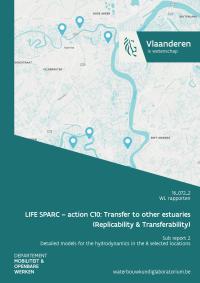Gedaan met laden. U bevindt zich op: LIFE SPARC – action C10. Transfer to other estuaries (Replicability & Transferability). Sub report 2. Detailed models for the hydrodynamics in the 8 selected locations
LIFE SPARC – action C10. Transfer to other estuaries (Replicability & Transferability). Sub report 2. Detailed models for the hydrodynamics in the 8 selected locations
In the framework of the project LIFE-SPARC, one of the important goals is to investigate the effects of various engineering measures, such as de-embankments and flood control areas, in order to prepare the Scheldt estuary against climate change. There are eight project areas, including five de-embankments and three FCA-CRT areas, defined in the project. For assessing their influences on the hydrodynamics and evaluating the safety against flooding, a detailed 3D model is built based on the existing Scaldis 2013 model, with necessary mesh refinements and updates of bathymetry. Two different scenarios are studied, a normal scenario with average tide and upstream discharges, and a storm surge scenario from the event of Sinterklaas storm, in order to have the full picture of the possible effects from these measures. In nature, the de-embankments and the FCA-CRT areas will silt up. In order to understand the long-term evolution of these areas, an empirical sedimentation model is set up, with its inputs derived from the numerical model. The results show that the eight project areas are effective in the protection of the estuary against flooding, and can reduce the high water level significantly in a storm surge event. The sedimentation rates estimated by the empirical model suggest that it will take several decades before these areas silt up. Therefore, they are capable of being in operation until 2050 and likely many years after that.

Lees de publicatie
- Publicatiedatum
- Juni 2022
- Publicatietype
- Onderzoeksrapport
- Thema's
- Scheepvaart, waterwegen en zeewezen
- Auteur(s)
- Q. Bi, S. Smolders, J. Vanlede
- Reeks
- FHR reports 16_072_2